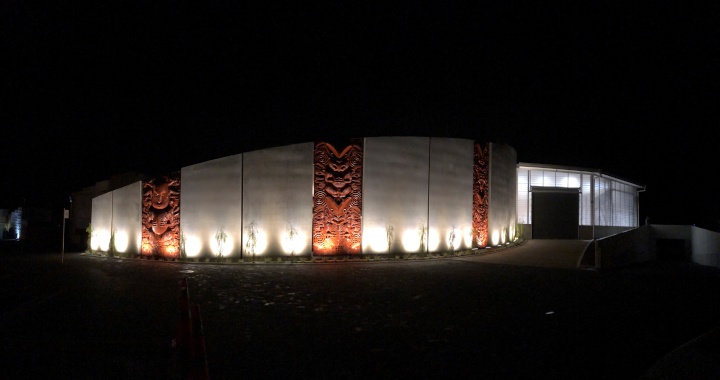Significant pou unveiled as Te Puia l NZMACI site
20 December 2017
Significant pou unveiled as Te Puia l NZMACI site developments pass milestone

Weighing more than 2300kg each and standing up to 7m tall, three significant pou whakairo (carved panels) have been installed at the entrance of the New Zealand Māori Arts and Crafts Institute’s new Wānanga Precinct.
Located at Te Puia in Rotorua, the national schools of wood carving, weaving, stone and bone carving and bronze foundry are about to move into their new building, with construction work now turning to the transformation of the old carving school into the new gallery, tā moko (Māori tattoo) studio and administration space.
The entire Wānanga Precinct will officially open in April 2018, however manuhiri (visitors) will be able to watch the cavers in their new environment from mid-January.
Carved from tōtara, the three pou whakairo each recognise a prominent carving style from the Te Arawa tribal area and are examples of the finest works from Ngāti Whakaue, Ngāti Pikiao and Ngāti Tarāwhai.
NZMACI tumu whakairo (head of school), Arekatera Maihi says it is the first time the three main carving styles of this area have been officially acknowledged in one place, recognising the legacy of expert carvers gone by and the whakapapa (genealogy) that has been passed down to present day carvers.
“There is not one person at this carving school, students and tutors alike, who hasn’t worked on this kaupapa (initiative). From project lead and graduate carver, Grant Marunui, sketching the designs, to our staff and students working for months on the finer details.
“We believe these are the biggest carved pou in the country and we’re proud to see them gracing the entrance to our new wānanga and welcoming manuhiri into the heart of what we do.”
NZMACI tohunga whakairo (master carver), Clive Fugill says the smallest pou has been carved in the local style of Ngāti Whakaue and follows the design of famous Ngāti Whakaue carver and ancestor Pūkākī, however it does not depict him.
“The second pou, representing the Ngāti Pikiao style of carving, is similar to that of Ngāti Whakaue in its surface patterning, but offers a contrast in surface design with deep pākati (notches), adding movement to the carved piece.”
The third and largest pou represents the carving style of Ngāti Tarāwhai, which involves a similar design, but has haehae, or grooves, that is much wider and bolder, with the pākati being smaller.
Mr Fugill says carvers from Ngāti Tarāwhai were amongst the most prolific of all carvers from this region.
“Along with Ngāti Whakaue and Ngāti Pikiao, the three carried the torch of carving well into the 20th century.
“These carvers were key to the renaissance in Māori wood carving, supported by the work of NZMACI, which plays a fundamental role in keeping the art of carving alive, protecting, promoting and perpetuating Māori arts and crafts across New Zealand under its Act established in 1963.”
The Wānanga Precinct is just one part of significant site developments underway at Te Puia, which includes a new 300-seat whare kai (restaurant and function centre), due to open in July 2018, and a kiwi husbandry facility which will further enhance and enrich the visitor experience.
Manuhiri visiting Te Puia l NZMACI will be able to access the carpark directly from the new Hemo Gorge roundabout once it is fully open, providing visitors safe access to and from the Te Puia carpark, as well as an underpass for pedestrians and cyclists.
In 2018, the roundabout will feature a 12m high sculpture, forming the southern gateway to the city. Designed by NZMACI tumu (head) of Te Takapū o Rotowhio (theNational Stone and Bone Carving School), Stacy Gordine and the team, the sculpture aligns with the cultural concept of a waharoa (gateway), where before entering the area, the cultural significance of the place and its ancestors is acknowledged.
ENDS


 Bowel Cancer NZ: Broken Promise, Lost Lives - Govt’s Bowel Cancer Screening Pledge 98% Undelivered
Bowel Cancer NZ: Broken Promise, Lost Lives - Govt’s Bowel Cancer Screening Pledge 98% Undelivered NZFC: Apply For The New Zealand Film Commission’s He Kauahi Catalyst
NZFC: Apply For The New Zealand Film Commission’s He Kauahi Catalyst  Organ Donation NZ: Organ And Tissue Donation Helped Save And Improve The Lives Of Hundreds Of People In 2024
Organ Donation NZ: Organ And Tissue Donation Helped Save And Improve The Lives Of Hundreds Of People In 2024 Taupo District Council: Punarua Exhibition Arrives At Taupō Museum
Taupo District Council: Punarua Exhibition Arrives At Taupō Museum Office of Early Childhood Education: Teachers Are Paying The Price For Lack Of ECE Funding In The Budget
Office of Early Childhood Education: Teachers Are Paying The Price For Lack Of ECE Funding In The Budget Science Media Centre: Teen Dies After Controversial Tackle Game – Expert Reaction
Science Media Centre: Teen Dies After Controversial Tackle Game – Expert Reaction